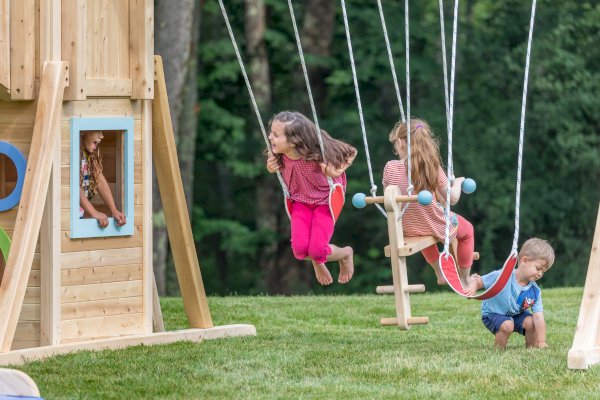Swing time: the many benefits of the simple swing
Benefits of Play | 4 years ago

We already know that active play and outdoor play have tons of benefits for kids’ development, but did you know that swinging on a playset in particular has a wide range of physical, developmental, and emotional benefits?
Swinging helps children develop their coordination, and motor planning. It’s actually pretty hard to learn how to maneuver and pump a swing, and it’s almost impossible to teach (seriously, if you’ve ever tried explaining it to your child, you know this is true). It’s something they just have to practice until they figure out how to coordinate the movements of their arms with their legs to make the swing move. This learning is great for their gross motor skills. Gripping the swing’s ropes also helps their fine motor skills including grip strength and hand, arm, and finger coordination.
Swinging on a swing is good exercise in general. It can condition joints, muscles, tendons, and ligaments, particularly working the core muscles which helps kids get stronger and improves their balance
With its simple rhythmic motion, swinging is a calming activity for kids. This might seem surprising given that we think of playing on a playset as a pretty high energy activity, but imagine swinging on a hammock. The back and forth motion stimulates the inner ear and has much the same effect as lying on a float on calm water.
Swinging can also help children to maintain focus and attention even after they are off the swings. Just a few minutes on a swing can carry on into the classroom, improving a child's ability to concentrate. It increases endorphins and blood flow to the brain helping the child to stay alert in class.
Swinging is also a true mood booster. There is something about the freedom of rushing through the air while controlling your speed and height that just puts people in a good mood. A kid who is pumping a swing might laugh or squeal, but they rarely frown or cry.
Swinging is especially great for sensory integration. It stimulates one’s sense of motion and vestibular orientation (essentially, your sense of balance and spatial orientation). When a child swings, they develop their ability to adapt to different sensations. Improved sensory integration helps a child focus, keep their hands to themselves or walk down the school hall without being overwhelmed by all the sensory input.
Swinging also helps with social development. It’s true that once a child learns to pump a swing by themselves, they can swing on their own, but swinging is still often very social. Kids can take turns pushing each other to see how high they can go. They also have to learn how to work together when there are more children than swings waiting their turn, practicing patience and cooperation. As anyone who has watched children on a playground knows, it doesn’t always work as smoothly as a parent would like, but it’s all part of the process of learning how to get along with others.
A few minutes a day playing on a swing is more than just a fun way to get excess energy out, it's great for kids' development.
Just a swinging, sliding and climbing! Michigan State University
Benefits of Swinging, School Specialty
Go ahead and soar: the countless benefits of swinging, Carolina Pediatric Therapy
#child-development#children
#family
#outdoor
#parenting
#play
#swing-set
#swings